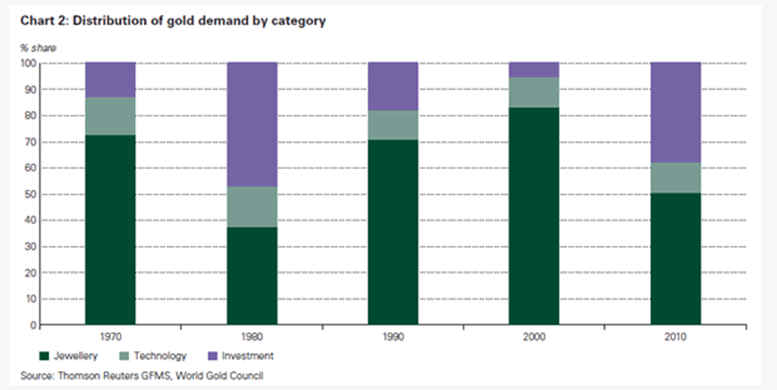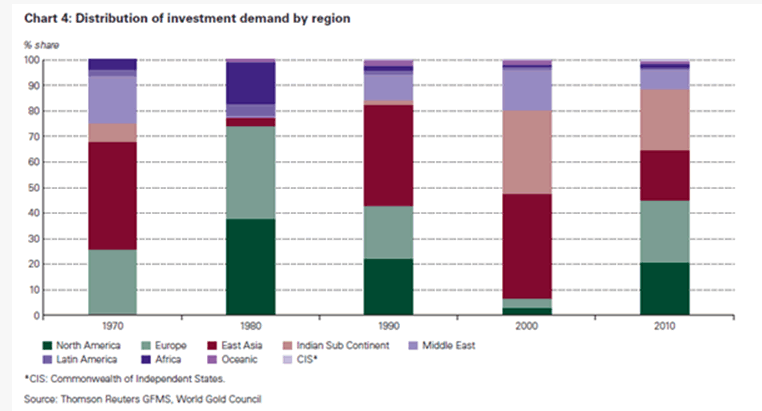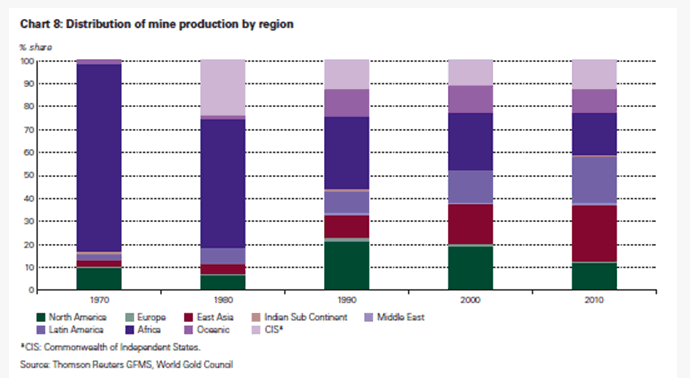Gold Takes Another Step Towards Reserve Currency Status?
Commodities / Gold and Silver 2011 Nov 21, 2011 - 10:48 AM GMTBy: William_Bancroft
 In the World Gold Council’s (WGC) latest quartley report on demand trends some interesting statistics were revealed which generally show a maturing in the gold market, especially in the geographical spread of demand and mine supply. We learn that third quarter gold demand increased a healthy 6% year-on-year to just over a thousand tonnes. A strong rise in investment demand was the main driver of overall demand and jewelry demand declined.
In the World Gold Council’s (WGC) latest quartley report on demand trends some interesting statistics were revealed which generally show a maturing in the gold market, especially in the geographical spread of demand and mine supply. We learn that third quarter gold demand increased a healthy 6% year-on-year to just over a thousand tonnes. A strong rise in investment demand was the main driver of overall demand and jewelry demand declined.
DEMAND:

This investment demand has helped gold outperform most other assets over the near term, delivering gains of 8% over the quarter and 15% over the year-to-date. What caught our attention was the nature of this investment demand, in comparison to previous gold market activity. The WGC report that:
‘The increase in investment demand during the third quarter was notable for its widespread geographical distribution. Virtually all markets saw strong double-digit growth in demand for gold bars and coins, with only three countries, India, Japan, and the US, experiencing a year on years contraction. These growth rates are all the more remarkable when considering the substantial bout of profit-taking which accomplished the price correction in September.’

It is encouraging to see that the investment demand base for gold is now well geographically diversified. Some analysts talk of differing business cycles unfolding in different geographies. As the far right column in the graph above shows, gold investment demand has a healthier looking geographical spread compared to that found during the top of the last gold market in 1980 (second column in from the left) where the market was predominantly driven by North America and Europe. The WGC find this geographical demand can be differentiated in motives and goals, commenting:
‘Western investors were attracted to gold’s insurance-like properties, given the worrying developments in the euro area. Meanwhile, investors in the Eastern markets focused on positive price expectations for gold as well as its inflation-hedging properties.’
Whatever the true motivation of various global market participants are the numbers continue to impress. What we found most notable within the growing gold investment demand, was the rebalancing of global participation in this market. North America and Europe were shown to have previously had a combined share of 47% of the global market in 1970, growing to 68% by 1980. This has since fallen to 38%, 28% and 27% respectively in 1990, 2000 and 2010. The decline in relative participation has been caused by ravenous demand from the East, with the Indian Sub-Continent and East Asia, rising from 35% in 1970 to 58% by 2010.
Within the gold investment demand, it was also encouraging but perhaps unsurprising to see the official sector also contributing. Central banks have become net buyers recently and the WGC report that:
‘Activity amoung central banks continued to fulfil our expectations of further purchases in Q3. In fact, net buying accelerated notably during the quarter – totalling 148.4 tonnes – as the issues surrounding the credit worthiness of western governments’ debt seeped into the official sector. A slew of new entrants emerged wishing to bolster their gold holdings in order to diversify their reserves. We see this trend continuining in 2012.’
Such a fundamental demand picture appears conducive of further appreciation in the gold price, and this now wider and stronger global demand base is part of the reason why analysts such as legendary trader James Sinclair believe that gold will surpass $10,000/ounce. This forecast might seem outlandish, but Mr Sinclair holds a fairly legendary position in the precious metals markets, and for good reason. Readers should note that when gold was a veritable back-water, in 2000, Mr Sinclair called for a price target of $1,760 in ten years’ time. His price target was hit in August 2011, rather poetically on the day of the August GATA conference in London. Being one year late with the realisation of his price target is extremely impressive. Can he forecast it correctly again? We cannot be sure, but he is better placed than almost anyone else to try.
The better diversified global investment demand has apparently also brought some stability to the gold price, which is reassuring for those that talk of gold as a store of value. Price volatility of an asset is not helpful when investors are looking to use gold as a savings mechanism and wealth preservation tool for their liquidity. This is good news and although volatility may have risen since 2008, the WGC tell us that:
‘This geographical demand shift is likely one of the reasons that average gold price volatility is lower for each represented year since 1980… Gold also becomes less susceptible to shard swings, heralding its value as a tail-risk hedge’.
SUPPLY:
When looking at the supply of gold to the market, the news also seems favourable. Scrap supply is still significant at circa 38%, but mine supply remained stable growing 2% year on year.

As members of the camp who urge gold as a store of value and effective savings mechanism, it was positive to see continued healthy balancing of gold’s geographical mining supply. During gold’s last bull market (1970 – 1980) the market was overly reliant on Africa, especially South Africa, for its supply. This presented a geographical risk to supply. Today gold supply is also geographically diversified on a global basis as the column on the right of the graph below shows us.

With a potentially more assured supply to the market, another potential cause of gold price volatility may be being sated. Today no single country provides more than 14% of global mine supply, and China is now the world’s largest producer (13%), followed by Australia (10%), the USA (9%), and Russia and South Africa (8% each). As the WGC comment:
‘This lack of concentration serves as a buffer against risks stemming from individual countries, a facet of gold that differentiates from the other precious metals, which have siginificant production concentration’.
This does indeed place gold apart form other precious metals, such as platinum where close to two thirds of supply comes from South Africa and and most of the remainder coming from Russia. It is for reasons such as this that observers like Rick Rule talk of investors and savers looking to gold for reasons of ‘fear’, but more speculative investors look to the white metals with a greater ‘greed’ motive.
GOLD AS MONEY:
Students of gold’s monetary role would have also been interested to note two statistics coming out of the Europen continent:
i) The growth in European investment demand of a staggering 135%, as Europe became the world’s largest gold investment market. As the European debt crisis has continued to grow from slight obscurity two years ago to a fully feldged international crisis, market participants have been increasingly drawn to gold’s uncorruptible reserve status free from counterparty risk. Anecdotal evidence from the recent Munich precious metals conference is suggestive of such demand, where commentators were amazed at the levels of physical up-take by conference attendees. Trust in government issued paper is collapsing, and gold, the antitheis of government debt, has been sought out.
ii) The more than doubling of demand for bars and coins in Switzerland. This demand jumped by 121% to 37.2 tonnes and was partially attributed to the surprising intervention of the Swiss National Bank (SNB) to essentially peg the Swiss Franc to the Euro. This phenomenon seems rather notable given that the Swiss used to enjoy one of the world’s most sound currencies. Although as Ned Naylor-Leyland urges, currencies like the Swiss Franc were always just ‘the best looking horses in the fiat glue factory’. With the SNB undermining the Swissie, the savings of millions of Swiss suddenly became less secure and they seem to have responded by trading in their paper for gold. Who can blame them.
SUMMARY:
Overall it seems all is healthy in the gold market. The fundamentals are all well established and demand sources show little sign of abating. Demand and supply are now geographically diversified as the gold market has matured this last 40 years. Within this, some of the largest market participants, the central banks, are now net buyers reinforcing gold’s monetary role. According to fund manager and noted analyst, Eric Sprott, this central bank activity in conjunction with a lack of IMF selling has caused ‘an 800 tonne swing in a 4,000 tonne market’. Such a 20% change in demand is significant indeed, and if kept up is conducive of further price appreciation.
A number of gold analysts have been suggesting that the markets are at a more or less advanced stage of their journey to attributing reserve currency status to gold (again). Although price volatility needs to be looked at more in fluctuations of the numeraire (usually US dollar), reduced price volatility would be helpful to perceptions of gold as a store of value and its ability to hold part of the world’s capital and savings. We are inclined to agree with this hypothesis of future reserve currency status, and find the WGC’s latest report some evidence of one more step down this road. In the medium and long term we feel gold’s investment case continues to strengthen and look for price discovery to higher levels.
Regards and good investing,
Will Bancroft
For The Real Asset Company.
Aside from being Co-Founder and COO, Will regularly contributes to The Real Asset Company’s Research Desk. His passion for politics, philosophy and economics led him to develop a keen interest in Austrian economics, gold and silver. Will holds a BSc Econ Politics from Cardiff University.
© 2011 Copyright Will Bancroft - All Rights Reserved
Disclaimer: The above is a matter of opinion provided for general information purposes only and is not intended as investment advice. Information and analysis above are derived from sources and utilising methods believed to be reliable, but we cannot accept responsibility for any losses you may incur as a result of this analysis. Individuals should consult with their personal financial advisors.
© 2005-2022 http://www.MarketOracle.co.uk - The Market Oracle is a FREE Daily Financial Markets Analysis & Forecasting online publication.



